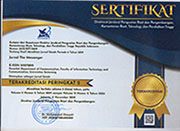Phygitally Yours: Examination of Virtual Reality Experiences in Digital Sports and Recreational Games
Abstract
Keywords
Full Text:
PDFReferences
Abbasi, A. Z., Ting, D. H., Hlavacs, H., Costa, L. V., & Veloso, A. I. (2019). An empirical validation of consumer video game engagement: A playful-consumption experience approach. Entertainment Computing, 29(SI), 43 55. https://doi.org/https://doi.org/10.1016/j.entcom.2018.12.002.
Abbasi, A. Z., Ting, D. H., & Hlavacs, H. (2017). Playful-consumption experience in digital game playing: a scale development. International Conference on Entertainment Computing, 290 296. https://doi.org/10.1007/978-3-319-66715-7_32
Abbasi, A. Z., Ting, D. H., & Jamek, A. B. S. A. (2015). An integrated conceptual model for predicting behavioral learning triggered by video-game engagement: A mediating role of observational learning. 2015 Game Physics and Mechanics International Conference (GAMEPEC), 11 15. https://doi.org/10.1109/GAMEPEC.2015.7331848
Alca ±iz, M., Bign ©, E., & Guixeres, J. (2019). Virtual reality in marketing: a framework, review, and research agenda. Frontiers in Psychology, 10, 1530. https://doi.org/https://doi.org/10.3389/fpsyg.2019.01530
Allison, A. (2017). Phygital is making online-offline experiences seamless. Campaignme.Com. https://campaignme.com/12236/
Babbie, E. R. (2017). The basics of social research (7th ed.). Cengage Learning.
Baird, A., & Raghu, T. S. (2017). Associating consumer perceived value with business models for digital services. European Journal of Information Systems, 24(1), 4 22. https://doi.org/https://doi.org/10.1057/ejis.2013.12
Belghiti, S., Ochs, A., Lemoine, J. F., & Badot, O. (2017). The Phygital Shopping Experience: An Attempt at Conceptualization and Empirical Investigation. Academy of Marketing Science World Marketing Congress, 61-74https://doi.org/10.1007/978-3-319-68750-6_18. https://doi.org/https://doi.org/10.1007/978-3-319-68750-6_18
Boyd, D. E., & Koles, B. (2019). Virtual reality and its impact on B2B marketing: A value-in-use perspective. Journal of Business Research, 100, 590 598. https://doi.org/https://doi.org/10.1016/j.jbusres.2018.06.007
Bronner, S., Pinsker, R., Naik, R., & Noah, J. A. (2016). Physiological and psychophysiological responses to an exer-game training protocol. Journal of Science and Medicine in Sport, 19(3), 267 271. https://doi.org/https://doi.org/10.1016/j.jsams.2015.03.003
Burke, R. R. (2018). Virtual reality for marketing research. Innovative Research Methodologies in Management, II, 63 82. https://doi.org/10.1007/978-3-319-64400-4_3.
Chaffey, D., & Ellis-Chadwick, F. (2019). Digital marketing (7th ed.). Pearson.
Chen, Y. C., Shang, R. A., Shu, C. Y., & Lin, C. K. (2015). The Effects of Risk and Hedonic Value on the Intention to Purchase on Group Buying Website: The Role of Trust, Price and Conformity Intention. Universal Journal of Management, 24(1), 85 114. https://doi.org/https://doi.org/10.1111/j.1365-2575.2012.00407.x
Chiu, C. M., Wang, E. T., Fang, Y. H., & Huang, H. Y. (2014). Understanding customers repeat purchase intention in B2C e - commerce: the roles of utilitarian value, hedonic value and perceived risk. Information Systems Journal, 24(1), 85 114. https://doi.org/https://doi.org/10.13189/ujm.2015.030605
Christensen, J. V., Mathiesen, M., Poulsen, J. H., Ustrup, E. E., & Kraus, M. (2018). Player Experience in a VR and Non-VR Multiplayer Game. Proceedings of the Virtual Reality International Conference-Laval Virtual, 1 4. https://doi.org/https://doi.org/10.1145/3234253.3234297
Clement, J. (2021). Virtual reality (VR) video gaming sales revenue worldwide from 2015 to 2020 (in billion U.S. dollars). Statista. https://www.statista.com/statistics/499714/global-virtual-reality-gaming-sales-revenue/
Csikszentmihalyi, M. (2007). Flow and the psychology of discovery and invention. HarperCollins.
Dickson, B. (2017). How Augmented Reality Is Transforming Work. PC Magazine. https://uk.pcmag.com/virtual-reality/91594/how-augmented-reality-is-transforming-work
Dombrowski, M., Smith, P. A., Manero, A., & Sparkman, J. (2019). Designing Inclusive Virtual Reality Experiences. International Conference on Human-Computer Interaction, 33 43. https://doi.org/https://doi.org/10.1007/978-3-030-21607-8_3
Dontigney, E. (2016). Brand Image Influence on Purchasing Intentions. Smallbusiness.Chron.Com. https://smallbusiness.chron.com/brand-image-influence-purchasing-intentions-70173.html
Earnshaw, R. A. (2014). Virtual reality systems. Academic press.
Fattal, A. L. (2019). Target intimacy: notes on the convergence of the militarization and marketization of love in Colombia. Current Anthropology, 60(19), 49 61. https://doi.org/https://doi.org/10.1086/699911
George, J. F. (2004). The theory of planned behavior and Internet purchasing. Internet Research: Electronic Networking Applications and Policy, 14(3), 198 212.
Gheisari, M., Foroughi Sabzevar, M., Chen, P., & Irizzary, J. (2016). Integrating BIM and panorama to create a semi-augmented-reality experience of a construction site. International Journal of Construction Education and Research, 12(4), 303 316. https://doi.org/https://doi.org/10.1080/01449290500330331
Hassenzahl, M., & Tractinsky, N. (2006). User experience-a research agenda. Behaviour & Information Technology, 25(2), 91 97. https://doi.org/https://doi.org/10.1080/01449290500330331
Heckathorn, D. D. (2011). Comment: Snowball versus respondent-driven sampling. Sociological Methodology, 41(1), 355 366. https://doi.org/https://doi.org/10.1111/j.1467-9531.2011.01244.x
Helm, S. V., Ligon, V., Stovall, T., & Van Riper, S. (2018). Consumer interpretations of digital ownership in the book market. Electronic Markets, 28(2), 177 189. https://doi.org/https://doi.org/10.1007/s12525-018-0293-6
Ho, J. C., & Zhang, X. (2020). Strategies for marketing really new products to the mass market: A text mining-based case study of virtual reality games. Journal of Open Innovation: Technology, Market, and Complexity, 6(1). https://doi.org/https://doi.org/10.3390/joitmc6010001
Hoffman, D. L., Novak, T. P., & Stein, R. (2013). The digital consumer. In R. Belk & R. Llamas (Eds.), The Routledge guide to digital consumption (pp. 28 38). Taylor & Francis. https://doi.org/https://doi.org/10.1007/s12525-017-0283-0
Huang, H. C., Pham, T. T. L., Wong, M. K., Chiu, H. Y., Yang, Y. H., & Teng, C. I. (2018). How to create flow experience in exergames? Perspective of flow theory. Telematics and Informatics, 35(5), 1288 1296. https://doi.org/https://doi.org/10.1016/j.tele.2018.03.001
Huang, T.-L., & Liao, S. (2015). A model of acceptance of augmented-reality interactive technology: the moderating role of cognitive innovativeness. Electronic Commerce Research, 15(2), 269 295. https://doi.org/https://doi.org/10.1007/s10660-014-9163-2
Hudson, S., Matson-Barkat, S., Pallamin, N. ., & J ©gou, G. (2019). With or without you? Interaction and immersion in a virtual reality experience. Journal of Business Research, 100, 459 468. https://doi.org/https://doi.org/10.1016/j.jbusres.2018.10.062
Javornik, A. (2016). Augmented reality: Research agenda for studying the impact of its media characteristics on consumer behaviour. Journal of Retailing and Consumer Services, 30, 252 261. https://doi.org/https://doi.org/10.1016/j.jretconser.2016.02.004.
Jeng, M. Y., Pai, F. Y. ., & Yeh, T. M. (2017). The virtual reality leisure activities experience on elderly people. Applied Research in Quality of Life, 12(1), 49 65. https://doi.org/https://doi.org/10.1007/s11482-016-9452-0
Jia, J., & Chen, W. (2017). The ethical dilemmas of virtual reality application in entertainment. 2017 IEEE International Conference on Computational Science and Engineering (CSE) and IEEE International Conference on Embedded and Ubiquitous Computing (EUC, 696 699. https://doi.org/https://doi.org/10.1109/CSE-EUC.2017.134
Kang, J. M. (2014). Augmented reality and motion capture apparel e-shopping values and usage intention. International Journal of Clothing Science and Technology, 36(6), 486 499. https://doi.org/https://doi.org/10.1108/IJCST-05-2013-0055
Kannan, P. K., & Li, H. A. (2017). Digital marketing: A framework, review and research agenda. International Journal of Research in Marketing, 34(1), 22 45. https://doi.org/https://doi.org/10.1016/j.ijresmar.2016.11.006
Kiili, K. (2005). Digital game €based learning: Towards an experientiallearning model. The Internet and Higher Education, 8, 13 24. https://doi.org/https://doi.org/10.1016/j.iheduc.2004.12.001
Kim, C., & Lee, S. (2000). Understanding the Cultural Differences in Tourist Motivation between AngloAmerican and Japanese Tourists. In T. K. S. Chon, Inagaki, & T. Ohashi (Eds.), Japanese Tourists: SocioEconomic, Marketing, and Psychological Analysis. Haworth Press. https://doi.org/https://doi.org/10.1300/J073v09n01_09
Kim, J., & Forsythe, S. (2007). Hedonic usage of product virtualization technologies in online apparel shopping. International Journal of Retail & Distribution Management, 35(6), 502 514. https://doi.org/https://doi.org/10.1108/09590550710750368
Kim, J., & Forsythe, S. (2010). Factors affecting adoption of product virtualization technology for online consumer electronics shopping. International Journal of Retail & Distribution Management, 38(3), 190 204. https://doi.org/10.1108/09590551011027122
Kotler, P. (2000). Marketing Management Millenium Edition. Prentice Hall.
Kotler, P., Kartajaya, H., & Setiawan, I. (2016). Marketing 4.0: Moving from traditional to digital (Hoboken). John Wiley & Sons.
Kounavis, C. D., Kasimati, A. E., & Zamani, E. D. (2012). Enhancing the tourism experience through mobile augmented reality: Challenges and prospects. International Journal of Engineering Business Management, 4, 10. https://doi.org/https://doi.org/10.5772/51644
Kozlowski, J. C. (2017). Park Permit for Location-Based Pok ©mon Go Games. Parks & Recreation, 62(1), 86 98.
Lee, J., Han, S., & Yang, J. (2011). Construction of a computer-simulated mixed reality environment for virtual factory layout planning. Computers in Industry, 62(1), 86 98.
Li, K. (2018). Convergence and de-convergence of Chinese journalistic practice in the digital age. Journalism, 19(9 10), 1380 1396. https://doi.org/https://doi.org/10.1177/1464884918769463
Li, Y., Zhang, Z., & Zhao, Y. (2016). Analysis on influencing factors of consumers purchasing behavior online for furniture. Proceedings of the 18th Annual International Conference on Electronic Commerce E-Commerce in Smart Connected World - ICEC 16, 1 8. https://doi.org/https://doi.org/10.1145/2971603.2971606
Logan, K. (2017). Why Virtual Reality Will Transform a Workplace Near You. Communications of the ACM, 60, 15 17. https://doi.org/https://doi.org/10.1145/3105444
Luo, M. M., Chen, J. S., Ching, R. K., & Liu, C. C. (2011). An examination of the effects of virtual experiential marketing on online customer intentions and loyalty. The Service Industries Journal, 31`(13), 2163 2191. https://doi.org/https://doi.org/10.1080/02642069.2010.503885
Miles, M, B., & Huberman, A. M. (1994). Qualitative data analysis: An expanded Sourcebook (2nd ed.). Sage.
Milner, R. M. (2016). The World Made Meme Public Conversations and Participatory Media. The MIT Press.
Moravcikova, D., & Kliestikova, J. (2017). Brand Building with Using Phygital Marketing Communication. Journal of Economics. Business and Management, 5(3), 148 153. https://doi.org/10.18178/joebm.2017.5.3.503
Murti, S., & Varshney, A. (2018). How Augmented Reality Will Make Surgery Safer. Harvard Business Review Digital Articles, 4, 2 5.
Noh, Z., Sunar, M. S., & Pan, Z. (2009). A Review on Augmented Reality for Virtual Heritage System. Learning by Playing. Learning by Playing. Game-Based Education System Design and Development Lecture Notes in Computer Science, 50 61. https://doi.org/https://doi.org/10.1007/978-3-642-03364-3_7
Nyl ©n, D., & Holmstr ¶m, J. (2015). Digital innovation strategy: A framework for diagnosing and improving digital product and service innovation. Business Horizons, 58(1), 57 67. https://doi.org/https://doi.org/10.1016/j.bushor.2014.09.001
O brolch ¡in, F., Jacquemard, T., Monaghan, D., O connor, N., Novitzky, P., & Gordijn, B. (2016). The convergence of virtual reality and social networks: threats to privacy and autonomy. Science and Engineering Ethics, 22(1), 1 29. https://doi.org/https://doi.org/10.1007/s10676-019-09507-0
OdabaÅŸi, Y. (2017). Pazarlama Fijital D ¼nyanın Neresinde? Brandmap. https://www.brandmap.com.tr/product-page/brandmap-sayı-11
Papagiannidis, S., See-To, E., & Bourlakis, M. (2014). Virtual test-driving: The impact of simulated products on purchase intention. Journal of Retailing and Consumer Services, 21(5), 877 887. https://doi.org/https://doi.org/10.1016/j.jretconser.2014.02.010
Petrock, V. (2019). Virtual and Augmented Reality Users 2019. Emarketer. https://www.emarketer.com/content/virtual-and-augmented-reality-users-2019
Pierce, D. (2018). Virtual Reality Check! Long Touted as Promising Ed Tech Tools, Virtual and Augmented Reality Are Finally Making a Real Impact on Teaching and Learning. THE Journal (Technological Horizons In Education), 45(2), 14 18.
Ponder, N. (2013). No Title. http://www.ffi.msstate.edu/pdf/consumer_attitudes.pdf
R., M. T. (2015). Getting Phygital, Embracing the space where digital and physical intertwine. School Library Journal, 6.
Roettl, J., & Terlutter, R. (2018). The same video game in 2D, 3D or virtual reality How does technology impact game evaluation and brand placements. Plos One, 13(7). https://doi.org/https://doi.org/10.1371/journal.pone.0200724
Schulz, P., Shehu, E., & Clement, M. (2019). When consumers can return digital products: Influence of firm-and consumer-induced communication on the returns and profitability of news articles. International Journal of Research in Marketing, 36(3), 454 470. https://doi.org/https://doi.org/10.1016/j.ijresmar.2019.01.003
Schwartz, A. M. (2011). Augmenting Purchase Intent: An Empirical Study on the Effects of Utilizing Augmented Reality in Online Shopping [University of California, Riverside]. https://papers.ssrn.com/sol3/papers.cfm?abstract_id=1858976.
Schwarz, S. (2011). Affiliate Marketing: A case study of Ticket Express.
Shelstad, W. J., Smith, D. C., & Chaparro, B. S. (2017). Gaming on the rift: How virtual reality affects game user satisfaction. Proceedings of the Human Factors and Ergonomics Society Annual Meeting, 2072 2076. https://doi.org/https://doi.org/10.1177/1541931213602001
Smith, B. (2017). Living in your design Virtual and augmented reality is enabling engineers. Roadsbridges. https://www.roadsbridges.com/living-your-design
Smith, R., & Swinyard, W. (1983). Attitude-Behavior Consistency: The Impact of Product Trial Versus Advertising. Journal of Marketing Research, 20(3), 257 267. https://doi.org/https://doi.org/10.1177/002224378302000304
Suh, K. S., & Lee, Y. E. (2005). The effects of virtual reality on consumer learning: an empirical investigation. Mis Quarterly, 29(4), 673 697. https://doi.org/https://doi.org/10.2307/25148705
Tongco, M. D. C. (2007). Purposive sampling as a tool for informant selection. Ethnobotany Research and Applications, 5, 147 158. http://ethnobotanyjournal.org/index.php/era/article/view/126/111
Tractinsky, N., Cokhavi, A., Kirschenbaum, M., & Sharfi, T. (2006). Evaluating the consistency of immediate aesthetic perceptions of web pages. International Journal of Human-Computer Studies, 64(11), 1071 1083. https://doi.org/https://doi.org/10.1016/j.ijhcs.2006.06.009
van Berlo, Z. M., van Reijmersdal, E. A., Smit, E. G., & van der Laan, L. N. (2021). Brands in virtual reality games: Affective processes within computer-mediated consumer experiences. Journal of Business Research, 122, 258 265. https://doi.org/https://doi.org/10.1016/j.jbusres.2020.09.006
Vivion, N. (2016). When digital meets physical: What Pok ©mon Go means for the travel industry,. Sabre. https://www.sabre.com/insights/when-physical-meets-digital-what-pokemon-go-means-for-the-travel-industry/
Wooden, S. (2018). Comparative Analysis of The Effects Of Virtual Reality Active Video Game And Controller-Free Active Video Game Play On Physiological Response, Perceived Exertion, And Hedonic Experience [College of Engineering and Computer Science]. https://stars.library.ucf.edu/etd/6164/
Yee, N., Bailenson, J. N., & Ducheneaut, N. (2009). The Proteus effect: Implications of transformed digital self-representation on online and offline behavior. Communication Research, 36(2), 285 312. https://doi.org/https://doi.org/10.1177/0093650208330254
Yoo, B., Donthu, N., & Lee, S. (2000). An examination of selected marketing mix elements and brand equity. Journal of the Academy of Marketing Science, 28(2), 195 211. https://doi.org/10.1177/0092070300282002
Y ¼ce, A., Katirci, H., & G ¶kce, S. (2017). From Traditional to Digital Sports Marketing: A Conceptual Study. The Journal of Academic Social Science Studies, 55, 543 556. https://doi.org/http://dx.doi.org/10.9761
Zhai, X., Wang, M., Zhou, R., Anwar, M. A., Saneinia, S., Ahmad, I., Li, M., & Asmi, F. (2020). The Nexus Between VR Affordability, Cognition, and VR Addiction: A Gaming Perspective. 6th International Conference of the Immersive Learning Research Network.
DOI: http://dx.doi.org/10.26623/themessenger.v13i1.2481
Refbacks
- There are currently no refbacks.
Copyright (c) 2021 Jurnal The Messenger
View My Stats [Jurnal The Messenger] is an International Scientific Journal, Published by the Department of Communication, Faculty of Information Technology and Communication, Universitas Semarang (Central Java, Indonesia). It is licensed under a Creative Commons Attribution 4.0 International License.



_11.jpg)




_BARCODE.jpg)
_BARCODE1.jpg)


5.png)










2.png)





